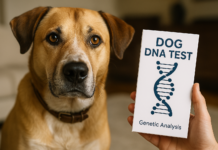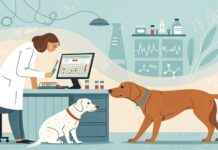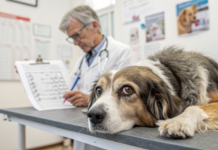Last Updated on September 29, 2023 by Dogs Vets
How to Help Your Dog Live a Longer, Happier Life
When it comes to ensuring your dog lives a long and happy life, several factors come into play. In this guide, we’ll provide you with actionable insights and advice to promote your dog’s well-being and longevity.
We will also explore 7 effective strategies to enhance your dog’s longevity and quality of life. These proactive measures not only benefit your beloved pet but are also cost-effective in the long run.
Let’s dive into the secrets of helping your dog live longer.
The Keys to a Longer Dog’s Life
7 Effective Strategies to help your Dog Live Longer
As dog lovers, we often wish our four-legged companions could stay with us forever.
While dogs’ lifespans are inherently shorter than our own, there are practical steps you can take to ensure your furry friend lives a long and fulfilling life.
1. Optimize Your Dog’s Diet for Longevity
Your dog’s diet plays a pivotal role in their overall health and lifespan. Just as we strive for balanced nutrition, our furry friends require the same.
Dogs are omnivores, meaning they thrive on a diet that includes both meat and plant-based components.
To ensure your dog’s well-being, consider these tips when selecting dog food:
- Choose food recognized by the AAFCO (American Association of Feed Control Officials) to meet essential dietary standards.
- Look for dog food labels that include AAFCO testing statements or have undergone feeding trials to validate their quality.
- Examine the top three ingredients on the label, which constitute the primary components of the food.
- Be cautious about misleading labels that use vague terms like “chicken dinner” or “beef stew.”
- Be aware that the term “with” on the label indicates a mere 3% of the mentioned ingredient.
Additionally, for aging dogs, consider diets containing omega-3 fatty acids or joint supplements, such as Hill’s Science Diet J/D, to proactively address joint health concerns.
While grain-free diets have gained popularity, recent studies suggest a potential link between such diets and heart disease in dogs.
Consult your veterinarian to determine if a grain-free diet is appropriate for your pet’s specific health and life stage.
-
Combat Overfeeding
Overfeeding is a common issue that can lead to obesity and various health problems in dogs. Maintaining a healthy weight is crucial for their longevity.
Be mindful of portion sizes and consult your veterinarian to establish an appropriate feeding plan based on your dog’s age, size, and activity level.
By controlling your dog’s caloric intake and ensuring they maintain a healthy weight, you can significantly extend their lifespan.
-
Regular Exercise is Vital
Exercise is not only essential for your dog’s physical health but also for their mental well-being. Engaging in daily physical activity helps maintain a healthy weight, prevents muscle atrophy, and stimulates their mind.
Tailor your dog’s exercise routine to their breed, age, and energy level. Whether it’s brisk walks, playtime at the park, or interactive toys, keeping your dog active is a key factor in prolonging their life.
-
Dental Care for Longevity
Proper dental hygiene contributes to your dog’s overall health and longevity. Dental issues can lead to infections and systemic problems, so make dental care a routine part of your dog’s health regimen.
Brush their teeth regularly, provide dental chews or toys, and schedule professional dental cleanings as recommended by your veterinarian.
-
Routine Veterinary Care
Regular check-ups with your veterinarian are essential to catch health issues early. Routine vaccinations, parasite control, and preventive care are vital components of your dog’s healthcare routine.
By addressing health concerns promptly, you can enhance your dog’s quality of life and potentially extend their years.
-
Provide Mental Stimulation
Mental stimulation is as crucial as physical exercise for your dog’s well-being. Interactive toys, puzzle feeders, and training sessions help keep their minds sharp and prevent boredom.
Engage your dog in activities that challenge their intellect and provide mental enrichment.
-
Create a Safe Environment
Lastly, create a safe living environment for your dog. Remove hazards and ensure your home is secure to prevent accidents and injuries. Keep toxic substances out of reach and provide a comfortable, stress-free space for your furry friend.
Conclusion: Helping your dog live a longer, healthier life is a rewarding endeavor that strengthens the bond between you and your loyal companion.
By following these seven strategies—optimal diet, controlled portions, regular exercise, dental care, veterinary check-ups, mental stimulation, and a safe environment—you can significantly improve your dog’s chances of enjoying a fulfilling and extended life by your side.
Remember, your furry friend brings you endless love and joy, so give them the gift of a longer, happier life.
FAQs
1. How can I choose the right dog food for my pet?
- Consult your veterinarian to determine the best diet for your dog’s specific needs.
2. What’s the ideal exercise routine for my dog?
- The right exercise routine depends on your dog’s breed, age, and energy level. Consult your vet for guidance.
3. Are there any natural supplements to enhance a dog’s lifespan?
- Some supplements, like fish oil and glucosamine, can promote joint and heart health in dogs. Consult your vet before using them.
4. Is dental care essential for a dog’s longevity?
- Dental health is crucial. Regular teeth cleaning can prevent dental issues that might affect overall health.
5. Can socialization with other dogs extend my dog’s life?
- Socialization can improve your dog’s mental well-being, but it should be in a safe and controlled environment.
6. How often should I visit the vet for check-ups?
- Typically, dogs should have annual check-ups, but the frequency may vary based on age and health status.
7. What role does a loving family play in a dog’s lifespan?
- Dogs thrive on love and affection. A caring and supportive family environment can lead to a longer, happier life.
By following these guidelines and providing your furry friend with the love and care they deserve, you can help ensure a longer and more joyful life for your canine companion.
Fact Check
We strive to provide the latest valuable information for pet lovers with accuracy and fairness. If you would like to add to this post or advertise with us, don’t hesitate reach us. If you see something that doesn’t look right, contact us!
Disclaimer: This article is for informational purposes only and should not replace professional veterinary advice.

















